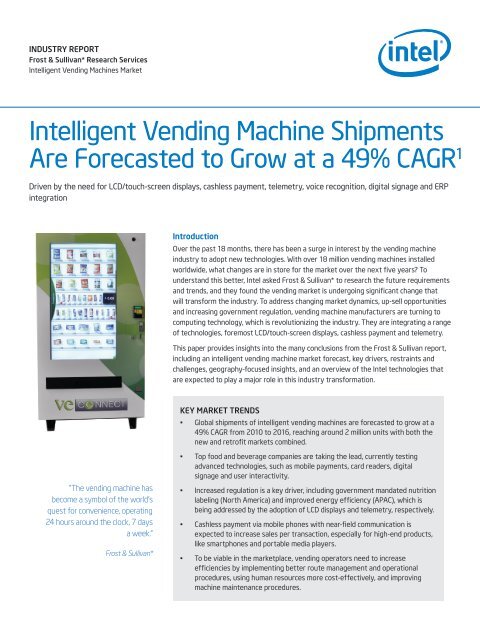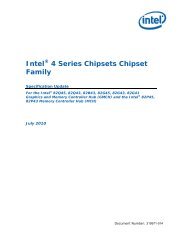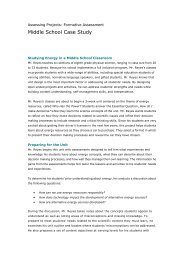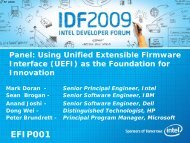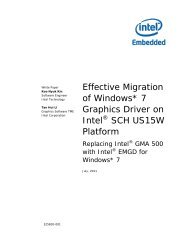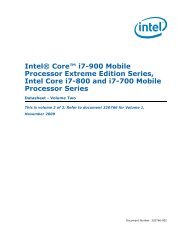Intelligent Vending Machine Shipments Are Forecasted To Grow
Intelligent Vending Machine Shipments Are Forecasted To Grow
Intelligent Vending Machine Shipments Are Forecasted To Grow
- No tags were found...
You also want an ePaper? Increase the reach of your titles
YUMPU automatically turns print PDFs into web optimized ePapers that Google loves.
Low-endvending machines94%Source: Frost and Sullivan*Figure 1. <strong>To</strong>tal <strong>Vending</strong> <strong>Machine</strong> Market: Product Market Share byUnits, 2010Note: This analysis defines an intelligent vending machine as one with anLCD/touch screen.What is an <strong>Intelligent</strong> <strong>Vending</strong> <strong>Machine</strong>?<strong>Intelligent</strong>vending machines6%The vending machine market comprises many players consistingof thousands of small operators and relatively few large or majorones. As of 2010, the total vending machine installed base wasestimated to be 18.7 million units, represented by machinesthat have sufficient space to accommodate LCD screens. Thisincludes large table top office vending service machines thathave enough surface area to potentially support 6 to 14 inch LCDscreens.The installed base is segmented in Figure 1, where an intelligentvending machine is one that has an LCD screen for interaction.While an LCD screen may seem like a low bar to qualify as anintelligent vending machine, it’s typically the first priority ofoperators who expect to incorporate other technologies, listedin Figure 2, over the next 3-5 years.Priorities for <strong>Intelligent</strong> <strong>Vending</strong> <strong>Machine</strong> Enhancements:• LCD: <strong>To</strong>uchscreen and interactive displays, typically rangingbetween 6 and 42 inches.• Cashless Systems: Payment by means of mobile phonesand credit/debit cards.• Telemetry Systems: Fixed or wireless connection forcommunicating machine health (i.e., sensor), inventorylevels, etc.• Voice Recognition: Another way for customers to interactwith the machine.• Digital Signage: High definition content medium: productinfo, graphical and video ads. Rich interactive content: whenused in conjunction with a touchscreen.• ERP: <strong>Vending</strong> machines communicating with corporatesystems: finance, planning, dispatch, maintenance.LCDCashlessSystemsTelemetrySystemsVoiceRecognitionDigitalSignageERPNorth AmericaEurope, Middle East, AfricaAsia PacificLatin AmericaImpact: High Medium LowFigure 2. The <strong>To</strong>p Priorities of Operators World-Wide for <strong>Intelligent</strong> <strong>Vending</strong> <strong>Machine</strong>sSource: Frost and Sullivan*2
FULL-FEATURED INTELLIGENT VENDING MACHINESVE Global <strong>Vending</strong>* (VEGV*) is revolutionizing vendingeveryday from its development offices in the United Statesand Europe. The company provides software, hardware andconsumer interface solutions that can be applied together orindividually to suit specific vending challenges. By offeringscalable solutions, VEGV is able to tailor solutions for vendingoperators’ specific needs and budgetary restraints. VEGVvending machines are based on Intel® processors, allowingthem to deliver a wide range of advanced features, including:• Anti-theft/Anti-vandal camerasUnits(millions)2.502.001.501.00<strong>Intelligent</strong> <strong>Vending</strong> <strong>Machine</strong>: Global Annual <strong>Shipments</strong>CAGR: 49%2.09• Anonymous facial recognition using Intel® AudienceImpression Metrics Suite (Intel® AIM Suite)• Product recognition allowing operators to control andmonitor vending transactions and interactions• Cashless payment using near-field communications• Full vending machine controller functionality where anIntel processor replaces previously-used microcontrollers<strong>Machine</strong> operators are supported by a comprehensive suiteof software tools for the above functions, as well as fordigital signage content management, telemetry, remotemanagement and communications, and the overall operationof the system. VEGV also implements the interactive vendingmachine interface called MIND (Make Informed NutritionalDecisions), which allows consumers to make informeddecisions, and operators to comply with new legislationin the United States and Europe mandating the display ofnutritional information.The VE Discover* integrates MIND technology with acontent-managed screen that allows the user to exploreproduct information and promotions, as well as executepayment and product selection on an interactive touchpadrather than a button keypad. The optional upper screenfeatures promotional content and advertising, while thelower touch screen displays product information andfacilitates the transaction, as shown in the picture.0.500.002008Figure 3. <strong>Intelligent</strong> <strong>Vending</strong> <strong>Machine</strong> Market: Annual Global Shipment2008-2016Market ForecastAnnual intelligent vending machine shipments are forecastedto exceed 2 million by 2016, after growing at a CAGR of49% beginning in 2010 (Figure 3). Worldwide, over half ofthe intelligent vending machine shipments will be retrofits,primarily adding a small LCD display and/or a card reader.Typically, system integrators retrofit the machine by installingpre-qualified kits from vendors specializing in this field.Key Market Drivers, Restraints and ChallengesBased on their vending machine market analysis, Frost &Sullivan identified key market drivers, restraints and challengesthat are expected to have significant impact on the industryover the coming years.Market Drivers:0.192009 2010 2011 2012 2013 2014 2015 2016• Opportunities enabled by mobile phonesSource: Frost and Sullivan*> Accept payments and transfer coupons with the swipe ofa phone using near-field communication technology.• Government mandates> Display product nutrition information and productwarnings (i.e., tobacco).• Increased user interactivity> Interact with both the customer and the customer’s smartphone, add intelligence to detect and respond to individualviewers, and provide a dynamically visual experiencewith high-definition displays running rich graphics andinteractive promotions.The VE Discover* gives the consumer an interactiveexperience and provides the vending operator and productcompanies with opportunities for promotions.3
• Remote management> Enable machines to contact vending operators by sendingand receiving real-time notifications via the cloud, thusdecreasing maintenance cost, increasing machine availabilityand automating restocking. The connected machines cancommunicate when they’re running low on product andfacilitate dynamic route optimization and other logisticefficiencies.• Software flexibility> Adopt general-purpose processors capable of easilysupporting new technologies and features in software, asopposed to hardware-focused, fixed-function platforms.• Pricing power> Command a higher price for products (e.g., coffee) by usinga vending machine’s high-end technology display andinteractivity to position them as higher quality than otherssold in machines.Market Restraints:• Measures banning vending machines in public locations> <strong>Grow</strong>ing regulation prohibits junk food sales in schools andtobacco use in public.• Return on investment (ROI) concerns> Economic slowdown and high technology costs deteroperators from upgrading machines.“ROBOT STORES”Responding to the special needs of various product manufacturersand operators, Investrónica*, headquartered inSpain, offers a range of vending machines to meet any requirement.The company is an innovator, incorporating theirexperience in sales management applications, payment terminals,automation, electronic sensing and control systems,secure payment media, communications and advertising.Pools of vending machines operate like a robot-store,marketing various products, including music, books, movies,video games, perfumes and telephones. They also provideservices, such as mobile recharge, travel agency, insuranceand ticket sales for events. The machines are attractivelydesigned and adaptable to specific needs, particularly spacerequirements, low maintenance, remote messaging aboutproduct and cash levels, and alarm monitoring.The machines combine the most advanced vendingfunctionality with the promotional potential of dynamicdigital signage displayed on an integrated 32 inch highdefinition touchscreen. These Intel® processor-basedsystems support cash or cashless payment via an RFIDcard or mobile device using near-field communication.Receipts and coupons can also be printed, and machinescan be equipped with a camera for anonymous audiencemeasurement or product identification via barcode.• Vandalism> Security issues in some locations limit high-end vendingmachine adoption.• Rental space costs increase significantly in some parts ofEurope> As rents rose 15% over the past few years, operatorsmoved or took back machines.• Low operating margins> <strong>Vending</strong> operators run their businesses on very narrowmargins and need to be able to justify the purchase of newtechnology with a large increase in revenue.Industry Challenges:• Energy management regulation> Emerging mandates require lower energy consumption andimproved monitoring.• Technology integration> Operators incorporating new technologies must integratenew protocols and standards.Investrónica* vending machines enable a self-service store.4
Geographic TrendsThe following presents a snapshot of geographic trends in thevending machine industry.North America will lead the adoption of intelligent vendingmachines – driven in large part by the need to implement LCDscreens for disclosing food and beverage calories per 2010 U.S.legislation.In Japan, the twin natural disasters, tsunami and earthquake,had a catastrophic effect on the vending machine industryand reduced the installed base; however, Japan is expected tomaintain its top position as an adopter of advanced vendingmachine technologies, such as telemetry and cashless systems.Additionally, Japan’s large install base of vending machines hasthe attention of government authorities who are concernedabout their overall power consumption, particularly for machinesthat keep soft drinks cold. In response, operators are dispatchingpersonnel to power on/off machine refrigeration throughout theday.In EMEA, Western European countries will continue to remain thehotbed for new vending technology adoption (see sidebars forexamples).Security threats and vandalism are expected to remain a majorthreat to the growth of the intelligent vending machine marketin countries such as Poland and South Africa.VENDING MACHINES WITH LARGE, CUSTOMER-AWARE TRANSPARENT DISPLAYSProviding a peek into the future of vending, Sanden Corporation*, Okaya Electronics* and Intel designed a concept modelthat incorporates a massive transparent touchscreen display and anonymous facial recognition capable of identifyingbasic characteristics of customers. This high-tech vending machine replaces the typical glass front-panel with a 65 inchtranslucent touchscreen, which allows customers to see the products behind the screen even as it plays high definition videoand animation. When patrons stand in front of the machine, it senses their age and gender and makes targeted productsuggestions based on anticipated tastes and preferences. This capability uses a sensor device mounted on the front of themachine and Intel’s anonymous viewer analytics solution, called Intel® Audience Impression Metric Suite (Intel® AIM Suite).With full high-definition (1920 x 1080 pixels) resolution, the see-through screen can display text, photographs and richanimations, powered by Flash* or other software, with a high degree of clarity. It consists of a conventional LCD panel with thebacklight unit (light source) removed and behaves like a sheet of glass. This allows people to watch various types of contentwhile seeing the products positioned behind at the sametime. In this concept model, the products inside the vendingmachine are illuminated by high-intensity LED lights,which also serve to make the images on the transparenttouchscreen visible.The display is also a touch panel so that menu selectionand other functions can be performed interactively. Whenthe vending machine is not in use, it attracts the attentionof potential customers by playing content such as a largedigital clock or animated animal characters. When someonestands in front of the vending machine, the signage contentchanges to show targeted advertisements or providedetails about the products the purchaser is considering.After the purchaser makes a selection, a brief, cheerfulanimation plays to express appreciation. The animationmoves in sync with the robotic mechanism that transfersthe product to the outlet.Concept Model Developed by Sanden Corp*.,Okaya Electronics* and Intel.5
Why Intel Technology in <strong>Intelligent</strong> <strong>Vending</strong> <strong>Machine</strong>s?As vending machines integrate advanced capabilities and becomemore connected, there’s a need to replace the microcontrollerused today with a higher performance CPU. This is where Intel®architecture processors excel, especially since they boostperformance when needed and conserve energy during periodsof low demand. Intel® processors have on-chip graphics thatcan drive HD displays and digital signage while using much lesspower than alternative standalone graphics cards. Productmanufacturers and operators can take advantage of thepowerful graphics capabilities of Intel processors to raise brandawareness and attract customers in increasingly dynamic ways.<strong>Vending</strong> operators can manage machines remotely using theinherent connectivity of Intel architecture-based vendingplatforms. If they want to update images or advertising contenton the display, or adjust the planogram or prices, they can do soquickly and securely — without leaving their office – whetherthey’re managing ten machines or ten thousand. Furthermore,Intel platforms with Intel® Active Management Technology (Intel®AMT) can be remotely diagnosed and repaired over the wire,which reduces machine downtime and service costs associatedwith sending a technician onsite. When it’s necessary to dispatcha technician, Intel AMT can help identify which replacement partsare required ahead of time, which avoids an extra trip.Telemetry is a priority for operators because it makes it easierto manage machines in the field. In support of telemetry, Intelplatforms can communicate and be managed over commonnetworks, including LAN, WiFi and 3G. Similarly well-connected,Intel platforms are ubiquitous in enterprises, so the technologyto interface to ERP systems is well established.With an increased focus on interactivity, Intel® AudienceImpression Metrics Suite (Intel® AIM Suite) uses AnonymousViewer Analytical facial detection technology to collect trackingand impression data for people viewing smart digital signs orvending machines – all anonymously and while respecting viewerprivacy. The technology allows operators to capture customerdemographic information, such as gender and age. For operatorslooking to implement voice recognition, Intel platforms have aproven track record among leading car navigation vendors.Intel sponsors a broad ecosystem of hardware and softwarevendors ready to make standard modules to address therequirements of embedded applications, like intelligent vendingmachines.For more information about Intel solutions for the vending industry, please visit www.intel.com/retail1Source: “Assessment of the <strong>Intelligent</strong> <strong>Vending</strong> <strong>Machine</strong>s Market”, Frost & Sullivan*, November 2011.Copyright © 2012 Intel Corporation. All rights reserved. Intel and the Intel logo are trademarks of Intel Corporation in the United States and/or other countries.*Other names and brands may be claimed as the property of others. Printed in USA 0212/TB/TM/PDF Please Recycle 326786-001US


